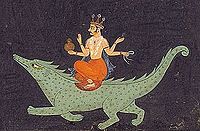Varuna (Devanagari: वरुण, IAST: varuṇa) is a god of the sky, of water and of the celestial ocean, as well as a god of law and of the underworld in Vedic religion.
Story
He is one of the most prominent Devas in the Rigveda and lord of the heavens and the earth. In later Hinduism, he continued his dominion over all forms of the water element, particularly the oceans.
Vedic and other roles
As chief of the Adityas, Varuna has aspects of a solar deity though, when opposed to Mitra, he is rather associated to the night and Mitra to the daylight. As the most prominent Asura, he is more concerned with moral and societal affairs than a deification of nature. Together with Mitra–originally oath personified—being master of ṛtá, he is the supreme keeper of order and god of the law.
Varuna and Mitra are the gods of the oath, often twinned or identified as Mitra-Varuna (a dvandva compound). Varuna is also twinned with Indra in the Rigveda, as Indra-Varuna.
As a sky god, Varuna may either correspond to or rule over the dark half of the sky or celestial ocean (Rasā). Hence, he is being sometimes considered also a god of rain (In the hymns, rain is more often associated to Mitra) or represent the 'dark' side of the Sun as it travels back from West to East during the night.
The Atharvaveda portrays Varuna as omniscient, catching liars in his snares. The stars are his thousand-eyed spies, watching every movement of men.
In the Rigveda, Varuna later became the god of oceans and rivers and keeper of the souls of the drowned. As such, Varuna is also a god of the dead who can grant immortality. From the name Varuna comes the name Varun which means wind. He is attended by the nagas. He is also one of the Guardians of the directions, representing the west. Later art depicts Varuna as a lunar deity, as a yellow man wearing golden armor and holding a noose or lasso made from a snake. He rides the sea monster Makara.
Varuna in the Ramayana
Faced with the dilemma of how to cross the ocean to Lanka where his abducted wife Sita is held captive by the demon king Ravana, Rama (an Avatar of Vishnu) performs a penance (tapasya) to Varuna, the Lord of Oceans, by fasting and meditating in perfect dhyana for three days and three nights. Varuna does not respond so Rama arises on the fourth morning, enraged by the God's arrogance. With his bow and arrow, he angrily begins attacking the oceans with celestial weapons and burning up the waters and killing its life and creatures. The Vanaras (Monkeys) are dazzled and fearful at witnessing the enraged Rama demolish the oceans, and his brother, Lakshmana, prays to calm Rama's mind. Just as Rama invokes the brahmastra, considered the most powerful weapon capable of destroying all creation, Varuna arises out of the oceans. He bows to Rama, explaining that he himself was at a loss to answer Rama's question. Begging him not to destroy the oceans with the missile, he suggests that Rama re-direct the weapon at a demonic race that lives in the heart of the ocean. Rama's arrows destroy the demons, and establish a purer, liberated environment there. Varuna promises that he would keep the oceans still for all of Rama's army to pass, and Nala constructs a bridge (Rama's Bridge) across to Lanka. Rama justifies his angry assault on the oceans as he followed the correct process of petitioning and worshipping Varuna, but obtaining the result by force for the greater good.

